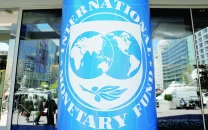The boom-bust fallacy
Policymakers must understand growth above 4% does not always lead to BOP crisis

The fear of boom and bust cycles, unique to our policymakers, once the economy exceeds an annual growth rate of more than 4%, thus leading to a balance of payments crisis, is a fallacy.
Before concluding on this misconception, one needs to understand what constitutes the definition of gross domestic product (GDP). Keynesian theory defines GDP as the total value of goods produced and services provided in a country during one year. GDP = consumption + investment + government spending + net exports (exports minus imports) or more succinctly as GDP = C + I + G + NX.
It is divided into three main groups: households, businesses, and the government. Households and businesses represent the private sector, whereas the government represents the public sector.
Now let's weigh the two in terms of their impact on the GDP of Pakistan. It is evident that our public sector today is oversized and ever more expanding, and our private sector is undersized and ever more shrinking. So, the question that comes to mind is: why? Well, the answer lies in years of bad economic policies and a drift away from free market principles.
Let's begin with the elephant in the room – the public sector. Government spending has consistently been on the increase year on year, with no end in sight for the last two decades. Government spending today stands at 20% of GDP, a huge amount for a developing country like Pakistan. Governments don't create wealth; they redistribute wealth by means of taxation and borrowing. Pakistan today has reached the limits on both.
Government spending is taxation, and the burden of taxation is solely borne by the private sector, and excessive borrowing is borne by our current and future generations. Enlargement of the public sector at the expense of the private sector is the wrong formula for sustainable economic growth.
The wealth creators are the private sector; they create jobs, produce goods and services, savings and investments, and above all, contribute much-needed tax revenues for the government.
Boom and bust cycles occur when the government spending and consumption – the G and C parts of the formula – outstrip the investment and exports – the I and NX in the equation. This imbalance is the driving force and the main contributor to these recurring crises. Government spending and frivolous consumption are nothing but a "sugar high," a temporary buzz that quickly fizzles out.
The public sector, by its reckless spending and excessive borrowing, crowds out the private sector. Businesses need capital to increase investments in order to produce and export to generate sufficient foreign exchange reserves to avoid a balance of payments crisis.
The aim of a good government is to stimulate production. Excessive taxation extinguishes both production and exports. Government should get out of the way and let the "animal spirits" of free markets do the necessary work through incentives. Economics is all about incentives. Market-friendly policies activate a country's economic immune system. It makes no sense killing the goose that lays the golden eggs.
To attain prosperity, Pakistan needs annual growth rates of plus 7% for the foreseeable future. A country's high GDP growth is the only solution to improving the per capita income of its citizens, especially when you take into consideration our annual population growth rate of 2.4% - one of the highest in the world.
Our Southeast Asian neighbours have shown that high growth rates have lifted their citizens out of poverty, increased their domestic and foreign investments, and led to robust exports without boom and bust cycles.
Rapid sustainable growth can only occur if supply-side economic policies, based on common sense, are implemented with a set of pro-growth policies: low tax rates on broad bases, government spending restraint, free trade, sound money, deregulation, and privatisation. It will jumpstart the economy in a relatively short period of time, leading to a path of sustainable economic growth without faltering in the near and long term.
Pakistan needs to accelerate its investment-to-GDP ratio from 13% to 30% and exports-to-GDP ratio from 10% to 30%, simultaneously reducing government spending-to-GDP ratio from 20% to 15% or less. We need to grow the economic pie with the private sector leading from the front and the public sector taking a back seat.
The government's job is to govern and provide the necessary infrastructure, health, and education that are much needed – not to run businesses, nor to overtax, overspend, and overregulate. A free market economy with the minimum of government footprint is the ultimate solution for any economy to grow, and growth matters. Many of our myopic politicians, bureaucrats, and the so-called "expert" economists, including the IMF, World Bank, and other international institutions, fail to see the whole picture from a supply-side perspective and adhere to the "run-of-the-mill" demand-side of economics.
The underlying causes of the recurring boom and bust cycles and balance of payments crisis are due to two main reasons out of the many: the first is the inadequate supply and demand balance, and the second is the outweighing of the public sector over the private sector in the GDP formula. No wonder it's a fallacy!
THE WRITER IS A PHILANTHROPIST AND AN ECONOMIST BASED IN BELGIUM





















COMMENTS
Comments are moderated and generally will be posted if they are on-topic and not abusive.
For more information, please see our Comments FAQ